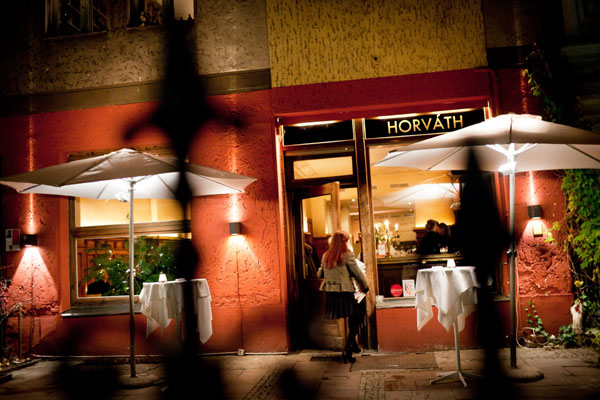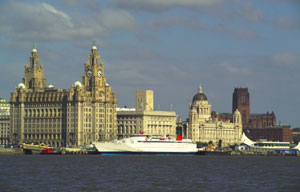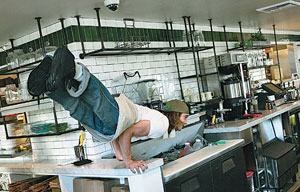Foie gras and stars in Berlin
Updated: 2013-03-04 09:42
By Molly Hannon (China Daily/Agencies)
|
||||||||
 |
|
Horvath's wood-paneled walls and dim lighting are reminiscent of an Alpine ski lodge. Provided to China Daily |
The pungent scent of foie gras and pork belly mingled with the strong odor of mustard greens one chilly winter evening in the dining room of a restaurant basking in its Michelin star.
The menu was worthy of an upscale Parisian bistro but the restaurant, Horvath, was actually a few train stops away, in Berlin.
The city now has 13 restaurants with Michelin stars, the most of any city in Germany. The stars, many bestowed in the last few years, are a signal that the country's culinary landscape has shifted from Munich and Hamburg.
"Ten years ago, no one would have imagined Berlin would have Michelin-starred restaurants," Christian Tanzler, spokesman for Visit Berlin, Berlin's leading tourism agency, says.
"After the wall fell, however, the city changed dramatically, and its progressive cosmopolitan flavor attracted artists, writers, but also chefs. The German cuisine, in particular the Berlin cuisine, began to slowly change."
Among the newest acclaimed arrivals is Horvath, whose wood-paneled walls and dim lighting reminiscent of an Alpine ski lodge belie its ambitious cuisine.
It overlooks the Landwehr Canal in Kreuzberg, a neighborhood that has in recent years transformed itself from a rundown area into a home to boutiques, ateliers and cafes.
"My restaurant does not look like a Michelin star place - at all - we do not have the money yet for decorating," Sebastian Frank, an Austrian who is the head chef at Horvath, says on a quiet weekday afternoon. "Right now, we care more about the quality of food and the wine." It won a star last year.
Lorenz Adlon Esszimmer in the elegant Hotel Adlon Kempinski next to Brandenburg Gate has a location that suggests old Berlin.
The restaurant's motto, however, is "Tradition eats modern."
It is reflected in Hendrik Otto's beautifully devised dishes, like cod drizzled with basil mustard sauce, which are drawn from local ingredients but were inspired by a tropical vacation during which the chef ate plain grilled fish doused in mustard.
These sorts of unusual dishes garnered it a second Michelin star last year.
A few blocks away in Mitte is Reinstoff, a much-lauded restaurant that also received two Michelin stars last year.
Its courses are organized according to sensory taste.
During a visit last year, that meant an amuse-bouche of goose liver on top of a corn waffle and a scaly wood mushroom salad intended to "wake up the senses," according to our server, followed by a montage of miniature mains: Norway king crab, gamy fawn, venison tataki with ginger, quince and licorice and a perfectly braised Charolais beef drizzled in garlic cream to "pamper our senses."
Reinstoff's unusual approach may not seem typical of Berlin, but the head chef, Daniel Achilles, again, blends local produce with international flavors.
That restaurants in Berlin, a city where reinvention is the norm, has rethought German cuisine should be no surprise. The attention that they are receiving for doing so is an unintended side effect. It is an exciting time for food here, and Michelin knows it.
The New York Times

 'Taken 2' grabs movie box office crown
'Taken 2' grabs movie box office crown
 Rihanna's 'Diamonds' tops UK pop chart
Rihanna's 'Diamonds' tops UK pop chart
 Fans get look at vintage Rolling Stones
Fans get look at vintage Rolling Stones
 Celebrities attend Power of Women event
Celebrities attend Power of Women event
 Ang Lee breaks 'every rule' to make unlikely new Life of Pi film
Ang Lee breaks 'every rule' to make unlikely new Life of Pi film
 Rihanna almost thrown out of nightclub
Rihanna almost thrown out of nightclub
 'Dark Knight' wins weekend box office
'Dark Knight' wins weekend box office
 'Total Recall' stars gather in Beverly Hills
'Total Recall' stars gather in Beverly Hills
Most Viewed
Editor's Picks

|

|

|

|

|

|
Today's Top News
Boston bombing suspect reported cornered on boat
7.0-magnitude quake hits Sichuan
Cross-talk artist helps to spread the word
'Green' awareness levels drop in Beijing
Palace Museum spruces up
First couple on Time's list of most influential
H7N9 flu transmission studied
Trading channels 'need to broaden'
US Weekly

|

|










